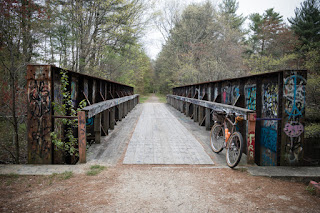Since I happen to have a bike that is better suited for roads not covered with asphalt, I've been searching for more such places to ride around Boston Metro area. So far, in search of the unpaved, I mostly visited locations north and west of Boston. The last weekend I decided to change that and try a trail in the south - the SNETT.
SNETT stands for the Southern New England Trunkline Trail. It's a path built in place of a former railroad, running from Blackstone, MA to Thompson, CT. Because I didn't want to just ride the same trail there and back, I decided to create a loop that would take me through three states: MA, CT and RI.
I started in Blackstone, where I left my car. Then I followed the paved Blackstone River Greenway to the end where it becomes unpaved and turns into SNETT. Actually, it's a bit difficult to navigate around the way these two trails merge. There is a section running alongside Rt146 - a busy highway, but eventually I was able to locate a path entering forest.
Unfortunately, this is where likely the worst part of the whole route was. We had a severe thunderstorm the night before and trails were still wet. The first section of SNETT was flooded and extremely muddy. I was moving forward very slowly, often walking on the trail's shoulder, trying to figure out how deep these puddles really were. I think memories from the previous year were still fresh, when I was going through Catamount State Forest and decided to just ride through the mud, only to spend the next half an hour pouring mud and water out of my shoes and trying to make myself somewhat presentable.
Fortunately, the rest of SNETT was in a better shape and I could pick up some speed. Just like many rail trails around, SNETT is flat, straight and... somewhat boring. In fact my initial impressions were not great and I thought that for someone who lives in that area, this trail would certainly be useful, but I wouldn't recommend to plan a whole day trip there just to ride on SNETT. Actually, the Rockingham Recreational Trail I visited not too long ago seemed much more interesting.
The good thing is that this changes once we get closer to Douglas State Forest. Here's where we find a more variety in scenery - from ponds, lakes, streams to wetlands and wildlife surrounding the trail.
In fact, I would say that if you happen to be in the area, it's likely worth parking in either Douglas, MA or East Thompson, CT and checking out that section of SNETT.
After spending the first 30km (18mi) on SNETT, I decided to head back but riding on main roads certainly isn't my kind of fun. I went south, into Rhode Island, to cross Buck Hill Management Area and find my way back east.
The path across was an ATV trail - rocky and sandy in places, but accessible by a mountain bike. From there I followed local roads to Black Hut State Management Area, which had trails of essentially the same kind - more rocks, more sand and more roots. And some fallen trees once a while. Both places looked pretty abandoned. It didn't look like they get many visitors in a year.
After 4hrs and 40min. I was back at my car in Blackstone. It turned out, I was there in likely the last possible moment to leave the town. It was Memorial Day and several blocks around Main St were already blocked off by police for the incoming parade. Had I made my ride any longer, I might've been stuck in Blackstone and unable to leave until the end of parade.


























